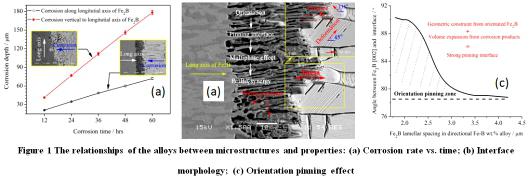By Shengqiang Ma
Liquid
metals with low melting point possess excellent thermal conductivity,
irradiation resistance and nuclear safety, which makes them more attracted.
However, the issue attacked violently by liquid metal corrosion is extensively
covered in many applications, such as the equipment corrosion in nuclear
industry cooling system, the corrosion of components in hop-dipping
galvanization, the erosion in slurry pump, the corrosion of liquid metal cell
and the casting die corrosion. In theses corrosion system, interface adhesion
plays an key role in protective interface reaction films of materials.
Meanwhile, interface film penetrability and dissolution reaction directionally
determine and control the interface behaviors of mass transfer process. Previous
studies mainly focused on the changes of corrosive medium environments or
concentrated on the adjusting alloying elements of the metal materials to
control the corrosion resistance of materials, which omits the significant
influence of interface microstructure of films on material performance.
Accordingly, the researchers of Xi'an
Jiaotong University in their work aim to the corrosion resistance of a
directionally solidified Fe-B alloy in liquid zinc and devote to the
microstructural two-phase synergistic effects of the alloys to generate a
multiphase pinning interfacial film with protectively pinning effect by delicately
controlling the interface micro-structures of the reaction films as a breakthrough
point. The formation of multiphase pinning interfacial film completes the
direct intervention of interface adhesion and mass transfer process through the
films, which accomplishes the control of the prolonged service life and
duration of materials in aggressive liquid metal corrosion. The present work
provides an studying idea and theoretical support on the aspects of the
"interface-performance" relationship.

The work was published in Acta Materialia and
Dr. Shengqiang Ma is the first and corresponding author. The work was also funded
by National Natural Science Foundation of China (NSFC) with grant Nos. 51301128
& 51271142 and the National Science Foundation for Post-doctoral Scientists
of China (2013T60875).
Access the full
article at: http://www.sciencedirect.com/science/article/pii/S1359645416304359


